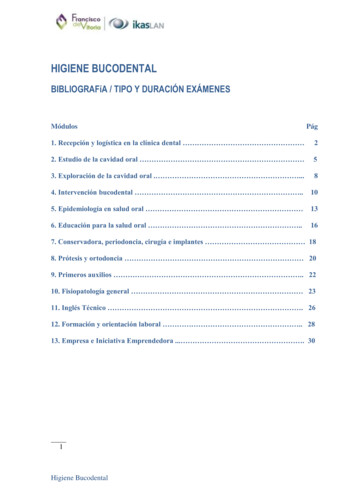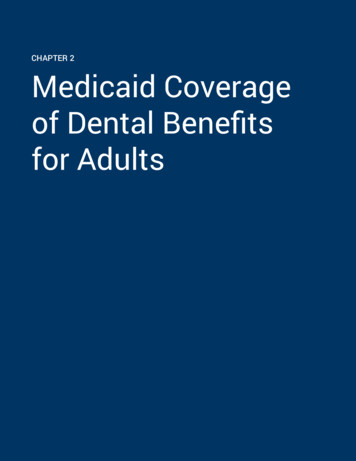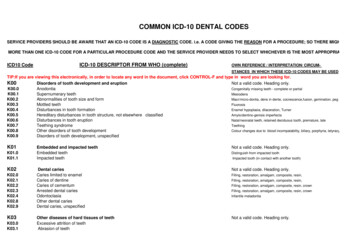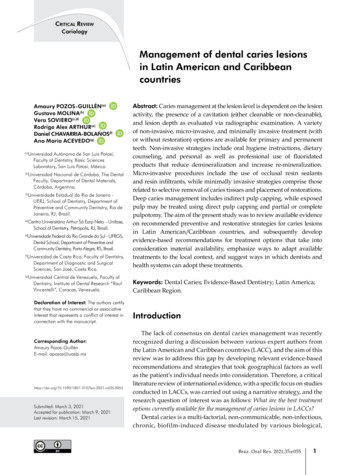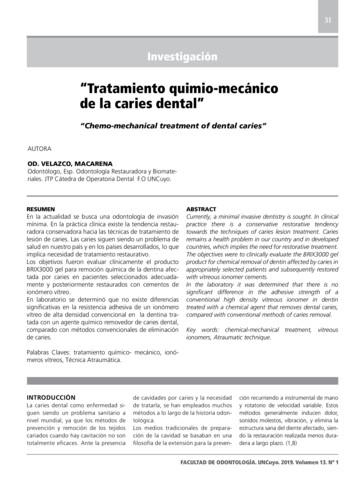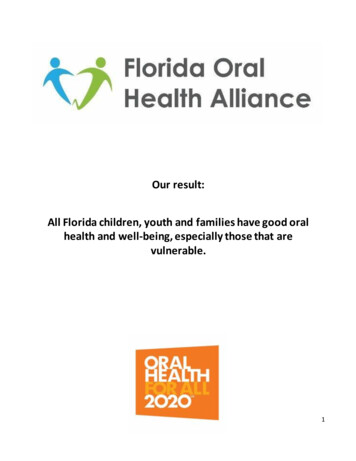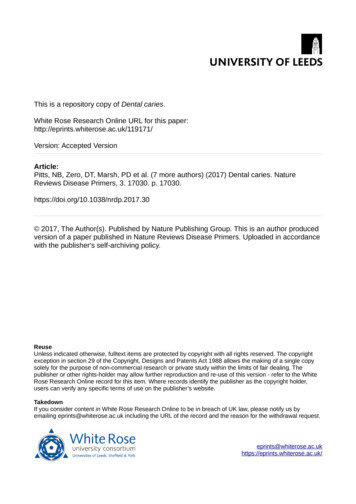
Transcription
This is a repository copy of Dental caries.White Rose Research Online URL for this n: Accepted VersionArticle:Pitts, NB, Zero, DT, Marsh, PD et al. (7 more authors) (2017) Dental caries. NatureReviews Disease Primers, 3. 17030. p. 17030.https://doi.org/10.1038/nrdp.2017.30 2017, The Author(s). Published by Nature Publishing Group. This is an author producedversion of a paper published in Nature Reviews Disease Primers. Uploaded in accordancewith the publisher's self-archiving policy.ReuseUnless indicated otherwise, fulltext items are protected by copyright with all rights reserved. The copyrightexception in section 29 of the Copyright, Designs and Patents Act 1988 allows the making of a single copysolely for the purpose of non-commercial research or private study within the limits of fair dealing. Thepublisher or other rights-holder may allow further reproduction and re-use of this version - refer to the WhiteRose Research Online record for this item. Where records identify the publisher as the copyright holder,users can verify any specific terms of use on the publisher’s website.TakedownIf you consider content in White Rose Research Online to be in breach of UK law, please notify us byemailing eprints@whiterose.ac.uk including the URL of the record and the reason for the withdrawal terose.ac.uk/
Final submitted and accepted Version from Nigel Pitts as at March 17th 2017Dental cariesNigel B. Pitts1, Domenick T. Zero2, Phil D. Marsh3, Kim Ekstrand4, Jane A. Weintraub5, FranciscoRamos-Gomez6, Junji Tagami7, Svante Twetman4, Georgios Tsakos8, Amid Ismail91Dental Innovation and Translation Centre, King's College London Dental Institute, Floor 17 TowerWing, Guy's Hospital, Great Maze Pond Road, London, SE1 9RT, UK.2Department of Cariology Operative Dentistry and Dental Public Health, Oral Health ResearchInstitute, Indiana University School of Dentistry, Indianapolis, Indiana, USA.3Department of Oral Biology, School of Dentistry, University of Leeds, Leeds, UK.4Department of Odontology, University of Copenhagen, Copenhagen, Denmark.5Department of Dental Ecology, University of North Carolina School of Dentistry, Chapel Hill, NorthCarolina, USA6UCLA Center Children’s Oral Health - UCCOH and Section of Pediatric Dentistry, UCLA School ofDentistry, University of California Los Angeles, Los Angeles, California, USA.7Cariology and Operative Dentistry, Tokyo Medical and Dental University, Tokyo, Japan.8Department of Epidemiology and Public Health, UCL, London, UK.9Restorative Dentistry, Maurice H. Kornberg School of Dentistry, Temple University, Philadelphia.USA.Competing interests:N.B.P. has received honoraria and corporate and social responsibility support from Colgate,consultation fees from Calcivis and holds stock in a Kings College London spin-out, Reminova. D.T.Z.has received contracted research funding from Johnson & Johnson, GlaxoSmithKlein, C3-Jian, andNoveome Biotherapeutics. P.D.M., K.E., J.A.W., F.R.-G., J.T., S.T., G.T., A.I. have no conflicts.Author contributionsIntroduction (N.B.P.); Epidemiology (N.B.P.); Mechanisms/pathophysiology (D.T.Z. and P.D.M.);Diagnosis, screening and prevention (K.E. and J.A.W.); Management (F.R.-G., J.T. and S.T.); Quality oflife (G.T.); Outlook (A.I.); overview of Primer (N.B.P.).1
Abstract Dental caries is a biofilm-mediated, sugar-driven, multifactorial, dynamic disease resultingin the phasic demineralization and remineralisation of dental hard tissues. Caries can occurthroughout life, both in primary and permanent dentitions, and can damage the tooth crown and, inlater life, also exposed root surfaces. The balance between pathological and protective factorsinfluences the initiation and progression of caries. This interplay between factors underpins theclassification of individuals and groups into caries risk categories allowing an increasingly tailoredapproach to care. Dental caries is an unevenly distributed, preventable disease with considerableeconomic and quality of life burdens. The daily use of fluoride toothpaste is seen as the main reasonfor the overall decline of caries worldwide over recent decades. This Primer aims to provide a globaloverview of caries, acknowledging the historical era dominated by restoration of tooth decay bysurgical means, but it focusses on current, progressive and more holistic long-term, patient-centred,tooth-preserving preventive care.2
[H1] IntroductionDental caries involves interactions between the tooth structure, the microbial biofilm formed on thetooth surface (Figure 1) and sugars, as well as salivary and genetic influences 1. The dynamic cariesprocess consists of rapidly alternating periods of tooth demineralisation and remineralisation which,if net demineralisation occurs over sufficient time, results in the initiation of specific caries lesions atcertain anatomical predaliction sites on the teeth. It is important to balance the pathological andprotective factors which influence the initiation and progression of dental caries. Protective factorspromote remineralisation and lesion arrest, whereas pathological factors shift the balance in thedirection of dental caries and disease progression 1 (Figure 2). The daily use of fluoride toothpaste isseen by many authorities as the main reason for the overall decline of caries worldwide over recentdecades; the mode of action of such toothpastes is concerned with shifting the balance of the oralbiofilm towards health.There is not a direct correlation between the extent of a caries lesion and whether or not pain anddiscomfort is felt. However, severe toothache, when it occurs, can be disabling and infection andsepsis arising as a consequence of caries spreading to involve the dental pulp can occasionally leadto serious systemic consequences (such as spreading local infection and, very rarelytreatmentrelated death (as a complication of anaesthesia), as well as to tooth loss.The clinical detection of caries is traditionally made by detailed visual inspection of clean teeth bytrained examiners. Although sharp pointed dental probes (or explorers) are still often used, theyprovide little additional diagnostic benefit and can do some damage. Dental radiographs or othersupportive diagnostic methods are also needed in clinical practice to detect those lesions whichremain hidden to visual assessment, particularly those situated on approximal tooth surfaces (thatis, those surfaces that form contacts between adjacent teeth).Although the ravages of caries can make teeth appear to be highly vulnerable to destruction bydisease, from an evolutionary biology perspective human teeth are a high valued organ systeminvolved in the prehension and processing of food, and can also function in defense, sexualattraction and phonetic articulation2. The outer surface of the tooth crown is composed of thehardest substance in the body (enamel) (Figure 1) with a specialized fluid (saliva) being secretedthroughout the day to preserve its integrity. The morphology of the modern dentition has evolvedmainly based on our dietary preferences, which have changed over the millennia2. Interestingly,3
diets high in sugar tend to be soft and often liquid; teeth are not required for their ingestion, whichmay explain why teeth can be rapidly lost.The aim of this Primer is to provide a balanced international overview of dental caries, both as acomplex, multi-factorial disease and as a dynamically fluctuating disease process. The article coversthe full range of perspectives from epidemiology to quality of life — via pathophysiology, diagnosis,risk assessment and prevention. Public health aspects are an important complement, but notcovered in depth for reasons of space. Current research evidence is helping to chart the way forwardto a more biologically-based way of planning and delivering caries prevention and care, at both thepopulation and individual levels. These considerations underpin the development of science,practice and policy to optimise patient care and health.4
[H1] EpidemiologyEpidemiological studies of caries have been undertaken for many decades and some of the dataavailable through WHO and other organisations gives an impression that we have plentifulcomparable global data. However, in order to evaluate and plan policy, epidemiology should providedata meeting the following specification: timely, accurate and understandable data for key agegroups on the total amount of disease present (prevalence), the rate of disease progression(incidence) and disease trends over time. In addition, information on variations in disease levelsbetween and within countries, including the estimates and trends in health inequalities (that is,differences in health status between groups within populations), are needed. However, we do notcurrently have accurate, up–to-date, clinically meaningful information across the globe that meetsthese specifications. Dental caries is still a neglected topic, despite the acknowledgment of the WHOthat is still a major health problem in most industrialized countries, where 60-90% of children andthe vast majority of adults are affected by dental caries3. Although caries has been considered adisease of childhood, in reality it continues into adulthood4, where health inequalities remain5.Dental caries are considered to be the single most common chronic childhood disease, and itsprevalence is thought to have increased recently in children ages 2-5 years globally, making this agegroup a global priority action area6,7,8. Census data from 2007 reported that for US children aged 2 to5, caries prevalence in primary teeth showed an increase, from approximately 24% to 28% between1988–1994 and 1999–2004 with caries rates being higher in children living in poor households orthose from ethnic minorities 9. In a more recent National Health and Nutrition Examination Survey(NHANES), from 2011-2012 approximately 23% of US children ages 2-5 years had dental caries inprimary teeth. In addition, the same data revealed that approximately 10% of US children ages 2- 5years had untreated dental caries. Dental caries prevalence shows marked differences in differentregions of the US. In a recent study using the NHANES data from 1999-2004, children in LA County,one of the largest US counties, were more likely to experience dental caries than the averagenumber across the US. Nearly 40% of preschool children residing in LA County had dental caries inprimary dentition compared to 28% of same age children in the US. Children residing in LA Countyhad less favorable oral health than children in the US in 1999-2004 with ethnic minorities having theworst 10 . Early childhood caries (ECC) – a very severe type of caries in children is a commonbacterially-mediated and multifactorial disease characterized by marked decay of the teeth ofchildren 6 years of age which is thought by some to be transmissible from caretakers to theirchildren but is fully preventable. Representative international data is patchy on ECC, as mostcountries only report caries from age 5 or 6 years.5
Traditionally, low caries prevalence has been observed in the developing countries, whereas theprevalence is higher in developed countries.3 This geographic situation has become more complexdue to speed of economic development and rapid changes in habits and diet in many countries.Although there might be gender or ethnic differences, they are minor compared with by sugarconsumption, lifestyle and economic differences.The traditional global index used to measure caries in epidemiological studies — but not clinicalpractice — is the DMF (Decayed, Missing and Filled) index, which is a numerical count of affectedteeth per individual collected at either the Tooth (DMFT) or tooth Surface level (DMFS). The count ofDMFT for an individual or group records their caries experience (that is, the total of both current andpast caries). The index can be used at the different diagnostic thresholds which affect both meanDMFT and the proportion of individuals affected11,12,13. Depending on the criteria used, proportion of15-year olds varies between 11-52% (Figure 3)14.Efforts are underway worldwide to improve our understanding of caries epidemiology by improvingmethodologies and optimising them for use in epidemiological field work, while also keepingcompatibility with systems used in a fully equipped dental practice. In epidemiology, theInternational Caries Detection and Assessment System (ICDAS) “Epi modifications”12, which can beused alongside the WHO basic reporting criteria13, have now been used in many countries,15 alongwith the more recent simplified merged-codes option16 (Figure 3). The merged ICDAS codes, whichare closer to those used in clinical practice, considers sound surfaces and three stages of caries asopposed to sound surfaces and six stages of caries in the full codes ICDAS option. It is also possible tocombine clinical and radiographic findings to reveal the full prevalence of caries17. Recent work by anumber of European organisations has shown — by way of a global example —that most of currentnational caries data for DMFT levels in 12-year-old children are not comparable across Europe15. Thishighlights the real challenges facing epidemiological studies on caries where apparently comparableresults from across a number of countries have, in fact, been collected at different time-points withvery variable levels of training and calibration and record caries at different thresholds.When oral health topics were added to the ongoing Global Burden of Disease Study18, oral diseaseswere found to be highly prevalent, affecting approximately 3.9 billion people worldwide. Themethodology used in this major study is useful because it allows comparison with other diseases interms of burden, but also novel from a caries epidemiology since it does not use the DMF Index6
(which has been used globally for the last 60 years). Untreated caries in permanent teeth was themost prevalent condition evaluated across all medical conditions, with a global prevalence of 35%for all ages combined with 2.4 billion people affected. Note that some of these permanent teeth willhave been in children and adolescents. Untreated caries in primary teeth in children ranked the 10thin prevalence, affecting 621 million children worldwide.[H1] Mechanisms/pathophysiologyThe mechanisms and pathophysiology underlying the development of dental caries are nowincreasingly well-understood and are best considered first from the hard tissue-related aspects (asthe disease affects the calcified dental tissues) and then from the microbiology (biofilm)-relatedaspects (as these represent the driver of the caries process if homeostatic imbalance is maintained)(Figure 1). However, because of the multifaceted nature of the disease process, these factors arenot independent. The dental hard tissues that are exposed to the oral environment (crowns andlater roots following gingival recession) are the targets of the caries disease process and all toothsurfaces are susceptible throughout an individual’s lifetime. However, caries will not occur in theabsence of a cariogenic (pathogenic) dental biofilm and frequent exposure to dietary carbohydrates,mainly free sugars19,20, and thus caries must be considered a dietary-microbial disease21. A modernconcept of caries also includes consideration of how behavioural, social, and psychological factors aswell as biologic factors are involved22,23,24. The importance of fluoride in modifying diseaseexpression cannot be overemphasised25 (Box 1). Perhaps dental caries can be best described as acomplex biofilm-mediated disease that can be mostly ascribed to behaviours involving frequentingestion of fermentable carbohydrate (sugars such as glucose, fructose, sucrose, and maltose)and poor oral hygiene in combination with inadequate fluoride exposure.[H2] Demineralization and remineralizationDental caries typically start at and below the enamel surface (the initial demineralisation is subsurface) and is the result of a process where the crystalline mineral structure of the tooth isdemineralized by organic acids produced by biofilm bacteria from metabolism of dietaryfermentable carbohydrates, primarily sugars. Although a wide range of organic acids can begenerated by dental biofilm microorganisms, lactic acid is the predominant end product from sugarmetabolism26 and is considered to be the main acid involved in caries formation. As acids build up inthe fluid phase of the biofilm, the pH drops to the point where conditions at the biofilm-enamelinterphace become undersaturated and acid demineralizes the tooth mineral so the surface layer ofthe tooth is partially demineralized27. The loss of mineral leads to increased porosity, widening of the7
spaces between the enamel crystals and softening of the surface, which allows the acids to diffusedeeper into the tooth resulting in demineralization of the mineral below the surface (sub-surfacedemineralization). The build-up of reaction products, mainly calcium and phosphate, fromdissolution of the surface and sub-surface raise the degree of saturation and can partially protect thesurface layer from further demineralization. Also, the presence of fluoride can inhibit thedemineralization of the surface layer28. Once sugars are cleared from the mouth by swallowing andsalivary dilution, the biofilm acids can be neutralized by the buffering action of saliva. The pH ofbiofilm fluid returns toward neutrality and becomes sufficiently saturated with calcium, phosphate,and fluoride ions so that demineralization stops and re-deposition of mineral (remineralization) isfavoured. Due to the dynamic nature of the disease process, the very early (subclinical) stages ofcaries can be reversed or arrested especially in the presence of fluoride.As demineralization progresses into the subsurface of the enamel and dentin in the case of rootcaries, with a continuing acid challenge and pH drop the rate of mineral loss becomes greater in thesubsurface than at the surface, resulting in the formation a subsurface lesion. When sufficientmineral is lost, the lesion appears clinically as a white spot. This is a clinically important stage of thecaries process, since the lesion can be arrested or reversed by modifying the causative factors orapplying preventive measures; however, the repair process is typically mostly restricted to thesurface layer.At this stage in its development, initial-stage caries (ICDAS codes 1 and 2) are considerablydemineralised, they may with changes in the local ecology, dietary practices and fluoride availabilityarrest and remain as they are ( inactive lesions which do not progress but remains still recognisableas a scar because of the changes in the optical properties of the enamel), remineralise andeffectively heal (re-precipitation of mineral in the lesion and possibly some superficial surface wearresulting in an apparently sound surface), or remain active and progress to a more extensive stage ofdestruction.If the caries process progresses further, the surface porosity increases with the formation ofmicrocavitations in enamel (ICDAS code 3) or in root caries — a progressive softening of the surfacedentine layer. In caries of the tooth crown the surface layer of the lesion may eventually collapse,resulting in physical cavitation (a macroscopic hole – ICDAS code 5 or 6). Even at this more extensivestage of caries severity, a lesion may in optimal circumstances still arrest, although the biofilmretaining cavity will persist. When an irreversible stage of lesion extent is reached (typically in most8
developed countries ICDAS 5&6), combined with symptoms and/or considerations of the functionalor aesthetic needs of the patient, operative intervention is indicated. If the caries process continueseventually the dental pulp will be compromised and either a root canal treatment or toothextraction will be necessary.For optimal tooth health, the main goal is to maintain the mineral homeostasis of tooth surfaces.Since teeth are frequently exposed to acidic conditions either from biofilm or dietary acids, theability to remineralize is essential to maintaining tooth integrity. Saliva is essential for preservationof tooth health by providing the minerals necessary for remineralization. Low levels of fluoridegreatly enhance this process, which largely explains the remarkable effectiveness of fluoride inmultiple delivery forms in reducing dental caries (Box 1)28.Dental caries is a dynamic disease process involving repeated cycles of demineralization andremineralization throughout the day27,29.Teeth are most susceptible to caries when they first erupt inthe mouth and over time become more resistant to subsequent acid challenge. The clinicalimplication is that there should be greater focus on monitoring the caries status of teeth anddelivering preventive care during the periods when teeth are erupting.[H2] Microbiology and dental biofilms[H3] Oral microbiota in health. The mouth, such as other surfaces of the body, is colonized frombirth by a diverse array of microorganisms (the oral microbiota)30. The most common group ofmicroorganisms are bacteria, but yeasts, viruses, mycoplasmas, protozoa and Archaea can bepresent. The oral microbiota has a symbiotic or mutualistic relationship with the host. The residentoral microorganisms benefit from a warm and nutritious habitat provided by the host and, in return,act to repel invading microbes, contribute to the host defences, and engage in cross-talk with thehost to down-regulate potentially excessive pro-inflammatory responses to commensal bacteria31.Saliva plays a critical role in maintaining this beneficial microbiota by buffering the oral environmentat a neutral pH (optimal for the growth and metabolism of most of the oral microbiota), whileproviding proteins and glycoproteins as nutrients.[H3] Dental biofilms. The oral microbiota grows on surfaces as structurally and functionallyorganised communities of interacting species, termed dental plaque32,33. Dental plaque is an9
example of a biofilm, the formation of which involves a number of stages34. Tooth surfaces arecovered by a conditioning film of proteins and glycoproteins (the acquired pellicle) that are derivedmainly from saliva , but also contains components from bacteria and their products, gingivalcrevicular fluid (that seeps from the junction between the gum and the tooth), blood, and food35(Figure 1). The acquired pellicle provides binding sites for adherence by early bacterial colonizers ofthe tooth surface leading to dental biofilm formation, and also acts as physical barrier preventingacid diffusion36.Bacteria can be held weakly and reversibly near the surface by long-range van der Waal forces (forcethat do not involve covalent or ionic bonds) between the external layers of the bacterium and thisconditioning film. Attachment becomes stronger and more permanent if interactions occur betweenmolecules on the bacterium (adhesins) and complementary receptors in the conditioning film 32.Secondary colonising species attach to the early colonisers (coadhesion), and the complexity of thebiofilm increases. The biofilm undergoes maturation, and numerous synergistic and antagonisticmicrobial interactions occur37. A matrix is formed, composed of bacterial exopolymers (polymersecreted in the external environment), including polysaccharides derived from sugar metabolism andDNA; the matrix helps to retain the biofilm on the surface and can influence the penetration andmovement of molecules within the biofilm37,38. The biofilm protect the bacteria against antimicrobialagents. The composition of these biofilms varies on different surfaces of the tooth due to subtledifferences in the local environmental conditions.[H3] Microbial aetiology of dental caries. The normally synergistic relationship between theresident microbiota and the host is dynamic and can be perturbed by changes in lifestyle oralterations to the biology of the mouth; these changes can predispose sites to disease. Risk factorsfor caries include the frequent consumption of fermentable dietary carbohydrates (especiallysucrose)39 and/or a reduced saliva flow40 . Numerous cross-sectional and longitudinalepidemiological studies have reported a shift in the balance of the microbiota at sites with cariescompared with sites with sound surfaces. Early studies of caries lesions found higher proportionsand incidence of Streptococcus mutans and S. sobrinus compared with sound enamel; lactobacilliwere isolated from advanced lesions40. These observations led to the proposal that caries are onlycaused by a limited subset of the many species found in dental biofilms (the ‘specific plaquehypothesis’) 41. However, as more epidemiological studies were performed, caries were observed in10
the apparent absence of these bacteria, whereas these organisms could persist on other surfacesthat remained sound.Subsequent laboratory studies confirmed that other bacteria found within dental biofilms could alsogenerate a low pH from sugars, whereas others could reduce the potentially damaging effect oflactic acid by using it as a nutrient source and converting them to weaker acids, or by generatingalkali from the metabolism of arginine or urea in saliva. These findings provided support for the‘non-specific plaque hypothesis’, in which caries is a consequence of the net metabolic activity of thebiofilm41. More recently, studies using classical culture or molecular approaches have foundassociations between caries and other groups of acid-producing and acid-tolerating bacteria,including a range of Bifidobacterium, Actinomyces and Propionibacterium species, and Scardoviawiggsiae.Subsequently, alternative concepts have been proposed based on ecological principles thatdescribe the events associated with caries42,43; these ecological plaque hypotheses are now generallyaccepted as the most plausible explanations of the microbial aetiology of caries (Figure 4). Theoriginal ‘ecological plaque hypothesis’ recognized the consistency of bacterial function (that is, rapidacid production and tolerance of the acidic conditions generated) in the absence of specificity inbacterial name, and emphasized the essential requirement of a caries-conducive environment (thatis, sugar-rich diet and/or low saliva flow). Microorganisms with traits that are relevant to caries canbe present in biofilms on sound enamel, but at a level or activity that is too low to be clinicallyrelevant42. Caries is a consequence of an unfavorable shift in the balance of the resident microbiotadriven by changes in the dental environment. The regular exposure of plaque to fermentable dietarysugars results in repeated conditions of low pH in the biofilms which will favour the growth andmetabolism of acid-tolerating bacteria while inhibiting beneficial organisms that preferentially growat neutral pH. Implicit in this hypothesis is the concept that disease can be controlled not only bydirectly inhibiting the implicated bacteria but also by interfering with the factors that drive thedeleterious shifts in the microbiota (that is, reducing the amount and frequency of sugar intake toprevent acidic conditions, or promoting the use of snacks containing alternative sweeteners thatcannot be metabolized to acid by oral bacteria)42. The ecological plaque hypothesis has recentlybeen developed further to reflect the ability of some oral bacteria to adapt to acid stress duringregular and prolonged conditions of low pH [the ‘extended caries ecological hypothesis’]43. Again,acidification of the plaque acts as the main factor selecting an acid-generating and acid-toleratingbacterial community, the development of which will increase the risk of caries43 .11
Dental caries, therefore, is not an example of a classic infectious disease but is aconsequence of an ecological shift in the balance of the normally beneficial oral microbiota, drivenby a change in lifestyle and oral environment. An appreciation of these principles opens up newavenues for caries prevention.[H2] Environment and dental cariesAlthough biofilm formation is a natural process and is an essential step for caries formation, thepresence of a biofilm on a tooth surface is not in and of itself an indication that disease is present. Itis only after a complex interaction of host factors, including the tooth surface, acquired pellicle andsaliva, and free sugars in the diet that the presence of the dental biofilm can lead to diseaseexpression over time.The unique environmental conditions that exist of each tooth site explain the highly localized andcomplex nature of the caries process whereby caries can occur at a specific location of the toothsurface and not on an adjacent tooth surface even when both appear to be covered by biofilm27.These include tooth-related factors that impact acid solubility (for example, tooth composition(imperfectly formed structure as in hypoplasias) and structure, and pre-eruptive and post-eruptivefluoride exposure, post-eruptive age of the tooth), and those that influence biofilm thickness andpathogenicity by creating areas of plaque stagnation (for example, tooth morphology, arch form,occlusion and tooth position) 36,37. Development defects (for example, enamel hypoplasia, acondition characterized by thin enamel ) may lead to increase acid solubility and loss of surfacestructure creating sites of plaque stagnation and increased risk of caries in primary teeth44. Cariessusceptibility can also be affected by proximity of teeth to salivary gland orifices, and salivary filmthickness and velocity at specific tooth sites36,37. Dental appliances (such as orthodontic appliancesand dentures) and faulty restorations can also increase caries susceptibility at specific tooth sites bycreating areas of stagnation encouragin
1 Final submitted and accepted Version from Nigel Pitts as at March 17th 2017 Dental caries Nigel B. Pitts1, Domenick T. Zero2, Phil D. Marsh3, Kim Ekstrand4, Jane A. Weintraub5, Francisco Ramos-Gomez6, Junji Tagami7, Svante Twetman4, Georgios Tsakos8, Amid Ismail9 1Dental Innovation and Translation Centre, King's College London Dental Institute, Floor 17 Tower
